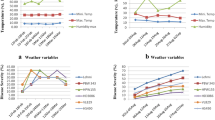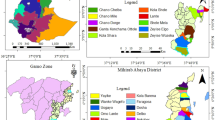Abstract
The cultivation of betelvine is hindered by a number of fungal and bacterial diseases resulting in heavy loss in leaf yield every year. Environmental factors play an important role on growth, dissemination and infection of pathogen as well as influence the expression of susceptibility/resistance of the host plant after infection. Therefore, an experiment was undertaken to study the influence of temperature, humidity and rainfall on the development of the diseases of betelvine under Jorhat conditions. The intensity of major diseases of betelvine viz anthracnose leaf spot caused by Colletotrichum capsici (Syd.) Butler and Bisby, and bacterial leaf spot caused by Xanthomonas axonopodis pv. betlicola (Vauterin et al. in Int J Syst Bacteriol 45:472–489, 1995) aggravated during rainy season. Percent Disease Index (PDI) of anthracnose leaf spot increased from 0% in November–March to 30.1% in July. PDI of bacterial leaf spot (30.6%) reached its peak during the months of August–September. Anthracnose did not appear during the months from November to April. However, PDI of bacterial leaf spot gradually decreased from September to 0% in March. Relationship between disease severity of anthracnose leaf spot and the meteorological parameters (maximum and minimum temperature, evening relative humidity and rainfall) was strong and positive. A moderate positive linear relationship was observed between disease severity of bacterial leaf spot and the meteorological parameters such as maximum temperature and evening relative humidity. However, strong positive linear relationship was observed with minimum temperature and rainfall.
Similar content being viewed by others
Avoid common mistakes on your manuscript.
Introduction
Betelvine (Piper betle L.) is a perennial dioecious creeper, belonging to the family Piperaceae. Betelvine plants have two types of branches namely, orthotropic (vegetative) and plagiotropic (reproductive) branches. It is an important commercial crop of India, Bangladesh, Sri Lanka and, to some extent, of Malaysia, Singapore, Thailand, Philippines and Papua New Guinea. In India, betelvine is commercially grown over an area of 54,000 ha providing livelihood to thousands of families engaged in its cultivation and trade. Betelvine is a shade loving plant and usually grown under closed system i.e. Khuti pan and Baroj type or under other supporting plants like Areca catechu, Sesbania, etc. Assam ranked second in betelvine cultivation covering an area of 12,500 ha and provides livelihood to thousands of families. Betel vine leaf contains vitamins, enzymes, thiamine, riboflavin, tannin, iodine, iron, calcium, protein and essential oil beneficial for liver, brain and heart. India is the largest producer of betel leaves in the world. The major constraint in cultivation of betelvine is its diseases that severely damage foot, stem, root and foliage Environmental factors play an important role on the growth, dissemination and infection as well as influence the expression of susceptibility/resistance of the host plant after infection. The serious diseases that cause heavy loss to the crop are anthracnose leaf spot [(Colletotrichum capsici (Syd.) Butler and Bisby] and bacterial leaf [X. axonopodis pv. betlicola (Vauterin et al. 1995)]. Leaf spot caused by C. capsici is also known as anthracnose of ‘Pan’. The epidemic form of the disease in the country had been reported by Basak et al. (1992) and Hossain et al. (1986). It may cause 10–60% yield loss (Singh and Joshi 1971) and reduce market value of the crop (Maiti and Sen 1982). Although some information about the control measure of the above mentioned diseases are available but influence of environmental factors on disease development are not much known and comprehensive attempts on epidemiology of the diseases have not been made so far. Therefore, an experiment was undertaken to study the influence of temperature, relative humidity (RH) and rainfall on the development of the diseases of betel vine under Jorhat (Assam) conditions.
Materials and methods
The experiment had been conducted at the Horticultural Orchard of Assam Agricultural University, Jorhat in the year 2013–14 (latitude of 26.7465°N and longitude of 94.2026°E). Initially, young cutting of betelvines cultivar ‘Asamiya Pan’ was used as planting materials. The cuttings were planted in plots maintaining 30 cm row to row, 10 cm plant to plant distance. After establishment of the cutting, the field was fertilized with only mustard oil cake at the rate of 6 metric tons per hectare per year. The oil cake was applied in two equal doses in the months of May and September. All cultural practices such as weeding, watering, earthing up, pruning, tieing, vine lowering and other operations were followed as per recommendation of Assam Agricultural University. Partial shade was provided with a thin roof made of straw and bamboo sticks.
The disease severity of leaf spot was recorded using 0–5 scoring scale (Goswami et al. 2002) from 25 randomly collected leaves where, 0 = healthy leaf, 1 = up to 5% leaf area covered, 2 = 6–15% leaf area covered, 3 = 16–30% leaf area covered, 4 = 31–50% leaf area covered and 5 = above 50% leaf area covered. It was expressed as percent disease index (PDI), which was computed using a standard formula (McKinney 1923) as shown below:
Disease scores were correlated with the meteorological data to find out the critical weather condition for the epidemiology of the disease. Simple correlation between the weather variables and disease severity (PDI) was determined for the cultivar following standard procedures (Gomez and Gomez 1984). Meteorological data were collected from the Department of Agrometeorology, AAU, Jorhat, Assam. The meteorological observatory is located 1 km away from the experimental site.
Results and discussion
Relationship between anthracnose leaf spot and weather parameters Anthracnose leaf spot was not noticed from November to March. It started appearing with gradual increase in temperature and pre-monsoon rainfall in late March. High disease severity was recorded during the peak monsoon months from July to September. It was the highest (30.1%) in the last week of July. Higher incidence of the disease was associated with high rainfall, temperature as well as RH (Table 1). Roy (1948) and Deka et al. (2005) recorded severe leaf spotting of betel vine due to anthracnose when rainfall was high. Das Gupta and Sen (1985) found that 92% RH was critical moisture level for severe leaf spotting and heavy losses of betel vine.
Regression line showed a strong positive linear relationship between disease severity and maximum and minimum temperature having coefficient, r = 0.6643 and r = 0.7928 and equation y = 27.303 + 0.231x and y = 15.392 + 0.441x, respectively (Fig. 1a). A strong positive linear relationship was observed between disease severity and RH (evening) having coefficient, r = 0.7342 and equation y = 62.918 + 0.482x (Fig. 1b). However, relationship between disease severity and RH (morning) was very weakly negative having r = − 0.1312 and equation y = 93.29 − 0.041x (Fig. 1b). A strong positive linear relationship was there between disease severity and rainfall with r = 0.6503 and equation y = 10.66 + 2.77x (Fig. 1c). Linear positive correlation with mean rainfall and severity of anthracnose leaf spot was also reported by Huq (2011).
Relationship between bacterial leaf spot and weather parameters Bacterial leaf spot caused by X. axonopodis pv. betlicola was more prevalent during rainy season. It was favoured by warm and humid condition during the period from June to September. In winter and summer months from mid October to May, disease severity was very low. Disease intensity increased with onset of rain in the month of June and reached the peak in August–September (Table 1). Maiti and Sen (1977) and Huq (2011) reported that the disease assumed epiphytotic form after the onset of rains in July and reaches its peak during July–October, when the temperature and humidity were fairly high. Sindhan and Bose (1980) opined that atmospheric temperature and humidity were important meteorological factors for development of different diseases. Under dry weather, the progress in disease severity was slow whereas during moist weather leaf spot enlarged rapidly causing rottening of whole leaf (Basak et al. 1992).
Co-relation study revealed a moderate positive linear relationship between disease severity and maximum temperature and strong positive relationship with minimum temperature. The respective coefficient were r = 0.6094 and r = 0.7379 with equation y = 27.224 + 0.225x and y = 15.183 + 0.436x (Fig. 2a). There was literally no relationship between disease severity and morning RH (r = −0.0691 and y = 93.149 − 0.023x). Moderate positive correlation was observed between disease severity and evening RH (r = 0.6124 and y = 59.987 + 0.624x) (Fig. 2b). Relationship between disease severity and rainfall was strong positive with coefficient r = 0.6503 and equation y = 10.66 + 2.77x (Fig. 2c).
From the above findings, it can be concluded that the three weather factors viz. temperature (minimum and maximum), RH (morning and evening) and rainfall greatly influenced the severity of betelvine diseases. Maximum disease severity was observed during rainy season. Percent disease indices of the major diseases (anthracnose leaf spot and, bacterial leaf spot reached the plateau in the months of July–September, when maximum temperature ranged from 30.6 to 35.1 °C, minimum temperature from 25.1 to 25.9 °C, RH (morning) from 82 to 95%, RH (evening) from 63 to 81% and the highest monthly rainfall of 480.1 mm in July. Total rainfall during these 3 months was 1063 mm. Higher minimum and maximum temperature, evening relative humidity and rainfall governed the development of anthracnose leaf spot in betelvine. Severity of bacterial leaf spot was greatly influenced by increasing minimum temperature and rainfall.
References
Basak AB, Mridha MAU, Jalil MA (1992) Studies on the leaf spot disease of Piper betle L. caused by Colletotricum piperis Petch. Chittagong University Studies. Science 16(2):87–91
Das Gupta B, Sen C (1985) Relationship of inoculum density of Colletotricum capsici and moister on leaf spot development in betel vine. Ind Phytopathol 38:364
Deka SN, Dutta PK, Bora LC, Saikia L (2005) Studies on leaf spot of betelvine caused by Xanthomonas and Colletotrichum in Assam. Karnataka J Hortic 1(2):84–87
Gomez KA, Gomez AL (1984) Statistical procedures in agricultural research, 2nd edn. Willey, New York, p 680
Goswami BK, Kader KA, Rahman ML, Islam MR, Malaker PK (2002) Development of leaf spot of betelvine caused by Colletotrichum capsici. Bangladesh J Plant Pathol. 18(1&2):39–42
Hossain AKMA, Elias SM, Mian MIH (1986) Report of the committee on betel leaf cultivation in Bangladesh. Bangladesh Agricultural Research Institute, Joydebpur, Gazipur, pp 12–16
Huq MI (2011) Studies on the epidemiology of leaf rot and leaf spot diseases of Betel vine (Piper betle L.). Bangladesh J Sci Ind Res 46(4):519–522
Maiti S, Sen C (1977) Leaf rot and foot rot of Piper betel caused by Phytophthora palmivora. Ind Phytopathol 30(3):438–439
Maiti S, Sen C (1982) Fungal diseases of betelvine. PANS 25:150–157
Mckinney HH (1923) Influence of soil, temperature and moisture on infection of wheat seedlings by Helminthosporium sativum. J Agric Res 26(5):195–217
Roy TC (1948) Anthracnose diseases of Piper betle caused by Colletotricum dasturi Roy. J India Bot Soc 27:96–100
Sindhan GS, Bose SK (1980) Epidemiology of angular leaf spot of french bean caused by Phaeoisariopsis griseola. Ind Phytopathol 33:64–68
Singh BP, Joshi LK (1971) Studies on the diseases of pan (Piper betle) in Jabalpur (Madhya Pradesh). Some new reports. Ind J Mycol Plant Pathol 1(2):150–151
Vauterin L, Hoste B, Kersters K, Swings J (1995) Reclassification of Xanthomonas. Int J Syst Bacteriol 45:472–489
Author information
Authors and Affiliations
Corresponding author
Rights and permissions
Open Access This article is distributed under the terms of the Creative Commons Attribution 4.0 International License (http://creativecommons.org/licenses/by/4.0/), which permits unrestricted use, distribution, and reproduction in any medium, provided you give appropriate credit to the original author(s) and the source, provide a link to the Creative Commons license, and indicate if changes were made.
About this article
Cite this article
Chakrabarty, R. Effect of environmental factors on diseases of betelvine (Piper betle) in Assam. Indian Phytopathology 71, 537–542 (2018). https://doi.org/10.1007/s42360-018-0076-1
Received:
Revised:
Accepted:
Published:
Issue Date:
DOI: https://doi.org/10.1007/s42360-018-0076-1






